Studies on Anti-Cancer Agents from Natural Resources with Special Reference to Cannabis sativa and Datura metel L. †
Abstract
1. Introduction
2. Method
2.1. Studying Molecular Docking
2.2. Selecting Proteins
2.3. Selecting Phytoconstituents
2.4. Docking
2.5. Comparing the Docking Scores of the Selected Receptors to the Phytoconstituents
3. Results and Discussion
4. Conclusions
Author Contributions
Funding
Institutional Review Board Statement
Informed Consent Statement
Data Availability Statement
Conflicts of Interest
References
- Nia, H.T.; Munn, L.L.; Jain, R.K. Physical traits of cancer. Science 2020, 370, eaaz0868. [Google Scholar] [CrossRef]
- Jassim, A.; Rahrmann, E.P.; Simons, B.D.; Gilbertson, R.J. Cancers make their own luck: Theories of cancer origins. Nat. Rev. Cancer 2023, 23, 710–724. [Google Scholar] [CrossRef] [PubMed]
- Bray, F.; Laversanne, M.; Sung, H.; Ferlay, J.; Siegel, R.L.; Soerjomataram, I.; Jemal, A. Global cancer statistics 2022: GLOBOCAN estimates of incidence and mortality worldwide for 36 cancers in 185 countries. CA A Cancer J. Clin. 2024, 74, 229–263. [Google Scholar] [CrossRef] [PubMed]
- Trayes, K.P.; Cokenakes, S.E. Breast cancer treatment. Am. Fam. Physician 2021, 104, 171–178. [Google Scholar] [PubMed]
- Smolarz, B.; Nowak, A.Z.; Romanowicz, H. Breast cancer—Epidemiology, classification, pathogenesis and treatment (review of literature). Cancers 2022, 14, 2569. [Google Scholar] [CrossRef] [PubMed]
- Nirmala, M.J.; Samundeeswari, A.; Sankar, P.D. Natural plant resources in anti-cancer therapy—A review. Res. Plant Biol. 2011, 1, 1–14. [Google Scholar]
- Koltai, H.; Shalev, N. Anti-cancer activity of cannabis sativa phytocannabinoids: Molecular mechanisms and potential in the fight against ovarian cancer and stem cells. Cancers 2022, 14, 4299. [Google Scholar] [CrossRef] [PubMed]
- Katoch, R.; Verma, S.P.; Agrawal, I.; Vyas, M.; Sahu, S.K. Exploring the Potential of Chemical Constituents of Datura metel in Breast Cancer from Molecular Docking Studies. BIO Web Conf. 2024, 86, 01042. [Google Scholar] [CrossRef]
- Clusan, L.; Ferrière, F.; Flouriot, G.; Pakdel, F. A Basic Review on Estrogen Receptor Signaling Pathways in Breast Cancer. Int. J. Mol. Sci. 2023, 24, 6834. [Google Scholar] [CrossRef] [PubMed]
- Rose, M.; Burgess, J.T.; O’Byrne, K.; Richard, D.J.; Bolderson, E. PARP inhibitors: Clinical relevance, mechanisms of action and tumor resistance. Front. Cell Dev. Biol. 2020, 8, 564601. [Google Scholar] [CrossRef] [PubMed]
- Wang, X.; Zhao, S.; Xin, Q.; Zhang, Y.; Wang, K.; Li, M. Recent progress of CDK4/6 inhibitors’ current practice in breast cancer. Cancer Gene Ther. 2024, 31, 1283–1291. [Google Scholar] [CrossRef] [PubMed]
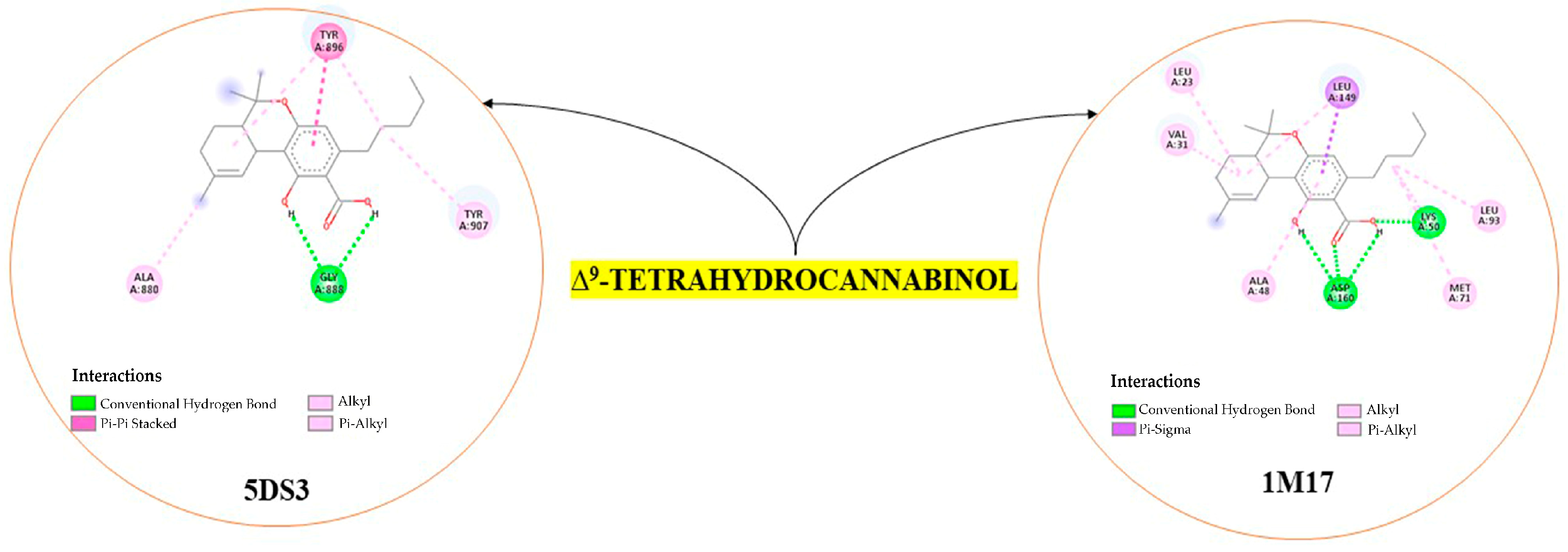
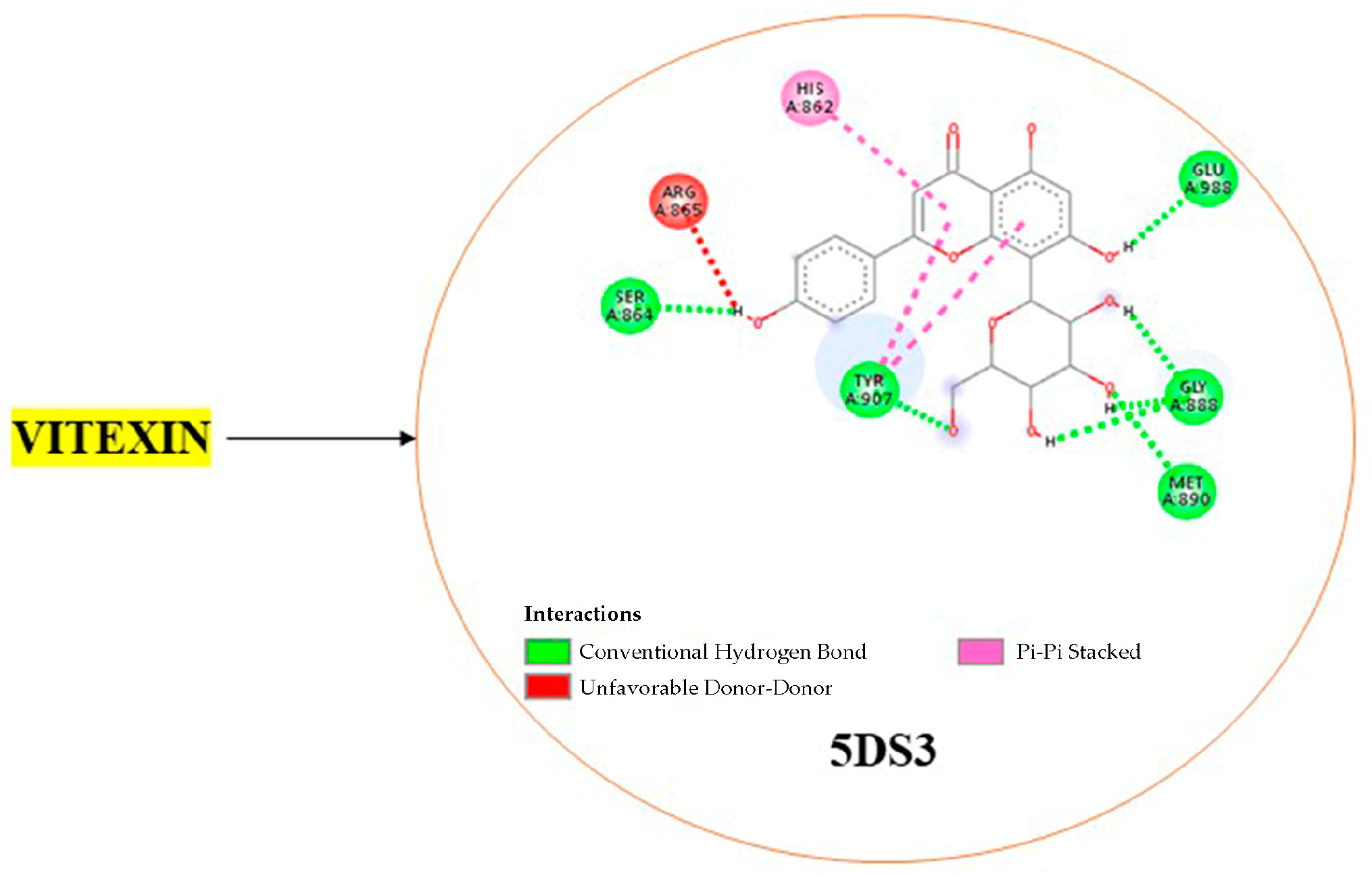
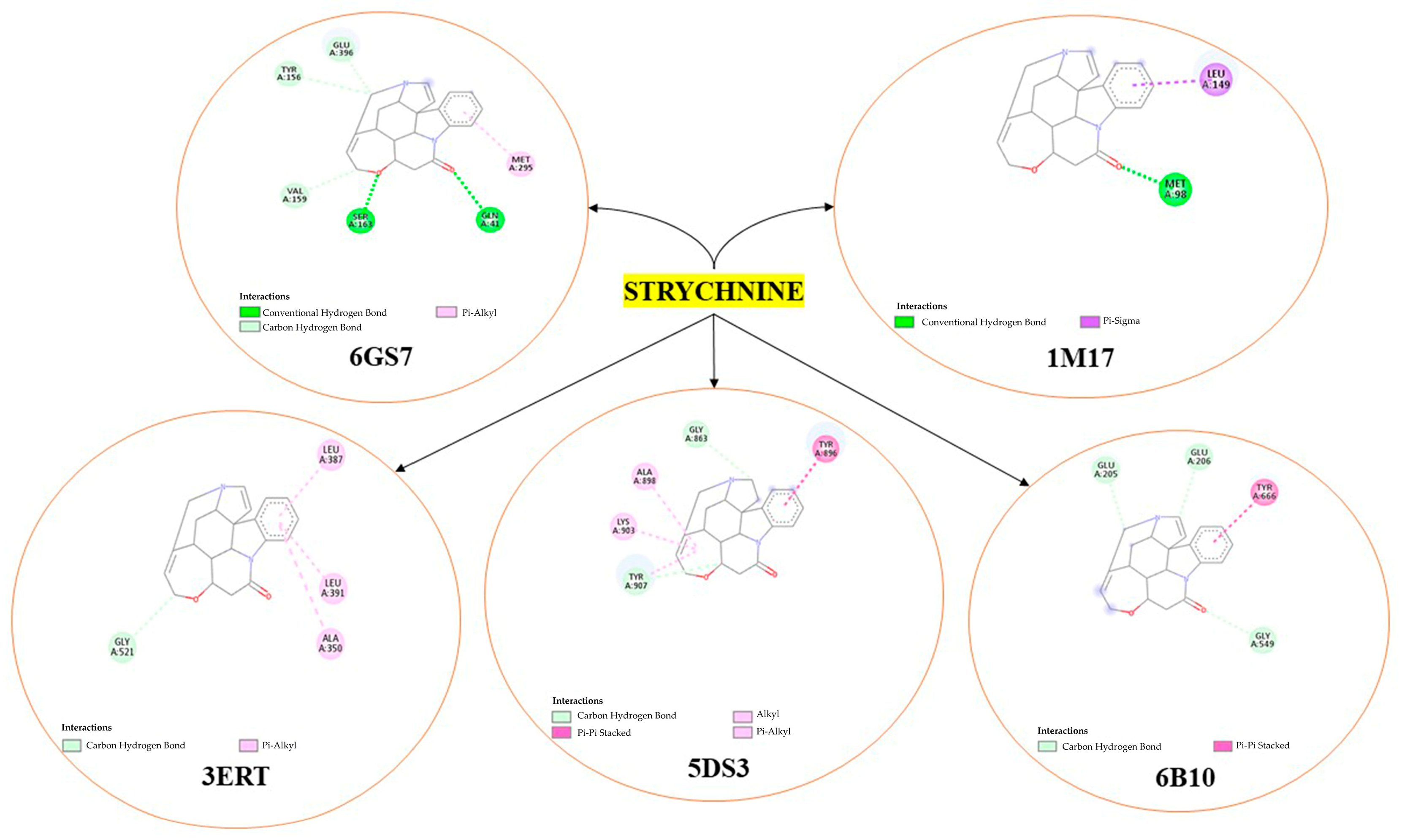
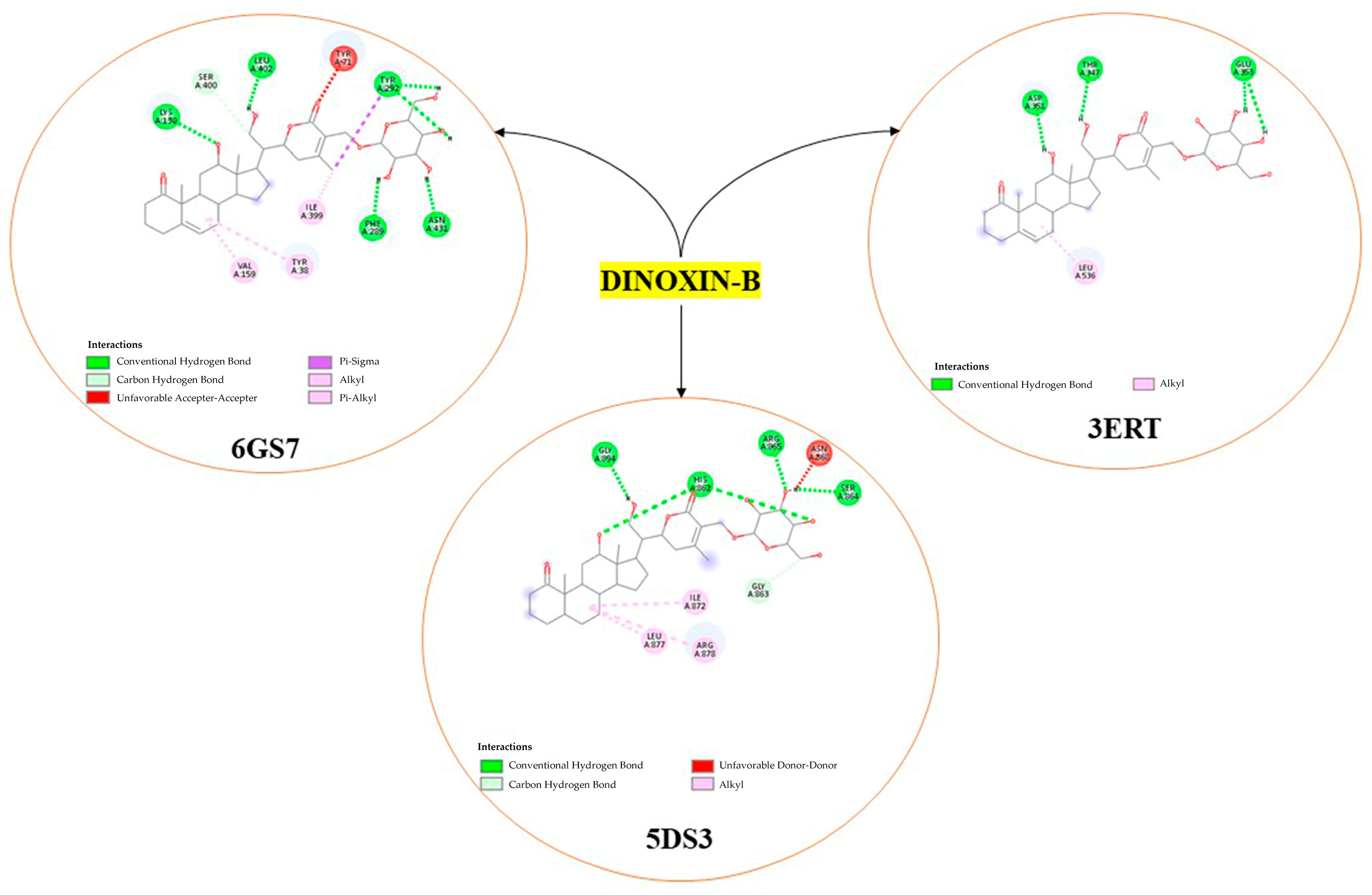
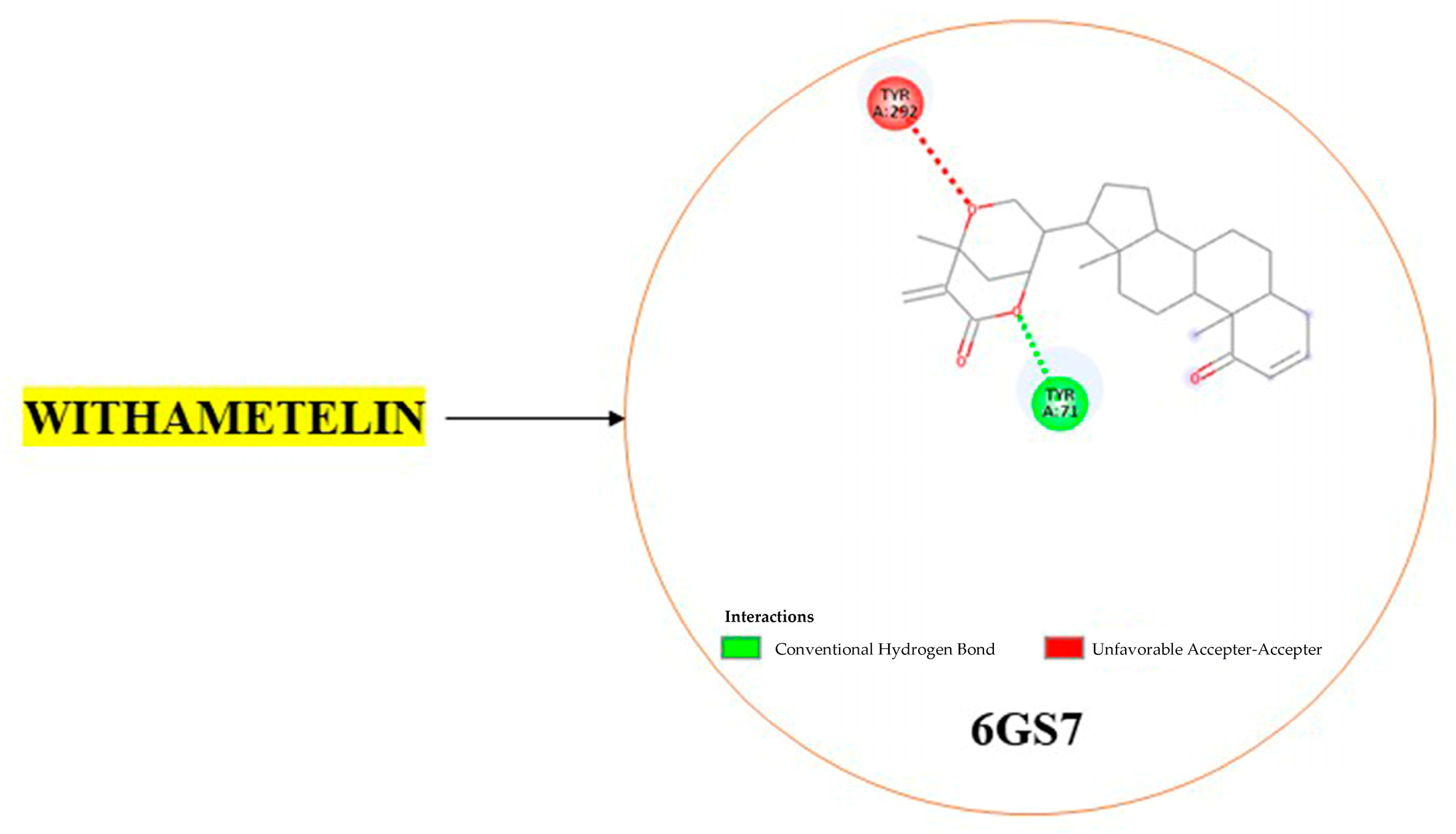

| Compound Name | CDK4/6 (PDB ID:6GS7) | EGFR (PDB ID:1M17) | Estrogen (PDB ID:3ERT) | PARP (PDB ID:5DS3) | PI3K (PDB ID:6B1O) |
|---|---|---|---|---|---|
| Apigenine | −7.09 | −6.83 | −8.13 | −8.15 | −6.61 |
| α-Humulene | −7.16 | −6.16 | −7.37 | −7.36 | −5.75 |
| Β-Caryophyllene Oxide | −7.29 | −6.73 | −7.56 | −8.35 | −5.74 |
| Luteolin | −7.29 | −7.14 | −8 | −7.94 | −6.42 |
| Cannabichromene | −8.36 | −7.68 | −8.41 | −8.26 | −7.35 |
| Cannabidiol acid | −7.94 | −6.79 | −7.25 | −7.14 | −7.02 |
| Cannabidiol | −8.38 | −7.08 | −7.95 | −7.48 | −6.84 |
| THCA | −8.19 | −8.56 | −8.17 | −8.84 | −6.52 |
| Cannabigerol | −7.73 | −6.94 | −7.41 | −7.95 | −7.01 |
| Rosmarinic acid | −6.1 | −7.07 | −7.47 | −7.99 | −3.6 |
| P-OH—benzoic acid | −4.64 | −4.56 | −3.71 | −4.97 | −3.94 |
| Gallic acid | −4.94 | −4.25 | −4.16 | −5.34 | −4.35 |
| Ferulic acid | −4.73 | −6.05 | −4.7 | −5.94 | −4.46 |
| Linalool | −4.93 | −4.87 | −5.75 | −5.5 | −4.95 |
| Epicatechin | −7.41 | −7.41 | −7.54 | −8.18 | −6.15 |
| Catechin | −7.4 | −7.44 | −7.54 | −7.91 | −7.09 |
| Naringin | −8.17 | −8.54 | −9.19 | −8.1 | −7.34 |
| Naringenin | −6.56 | −6.39 | −7.51 | −7.39 | −6.31 |
| α-pinene | −5.24 | −4.86 | −5.78 | −6.13 | −5.22 |
| Β-myrcene | −4.54 | −4.34 | −4.57 | −5.27 | −4.19 |
| Caryophyllene | −6.97 | −6.78 | −7.65 | −7.62 | −5.54 |
| Vitexin | −6.88 | −7.22 | −7.21 | −9.58 | −5.01 |
| Myrcene | −4.52 | −4.35 | −4.57 | −5.3 | −4.25 |
| Combretastatin | −7.6 | −6.83 | −6.34 | −7.59 | −6.08 |
| Strychnine | −8.93 | −8.95 | −9.99 | −9.73 | −8.73 |
| Compound Name | CDK4/6 (PDB ID:6GS7) | EGFR (PDB ID:1M17) | Estrogen (PDB ID:3ERT) | PARP (PDB ID:5DS3) | PI3K (PDB ID:6B1O) |
|---|---|---|---|---|---|
| Atropine | −7.18 | −6.96 | −7.27 | −7.11 | −6.55 |
| Dinoxin B | −10.39 | −4.38 | −10.72 | −8.55 | −5.52 |
| Scopolamine | −8.24 | −6.36 | −7.75 | −6.87 | −8.14 |
| Withametelin | −9.31 | −8.78 | −10.69 | −10.06 | −7.97 |
| Hyoscyamine | −7.08 | −6.43 | −7.25 | −6.94 | −6.62 |
| Withanolides | −8.67 | −6.72 | −9.29 | −9.72 | −5.91 |
Disclaimer/Publisher’s Note: The statements, opinions and data contained in all publications are solely those of the individual author(s) and contributor(s) and not of MDPI and/or the editor(s). MDPI and/or the editor(s) disclaim responsibility for any injury to people or property resulting from any ideas, methods, instructions or products referred to in the content. |
© 2024 by the authors. Licensee MDPI, Basel, Switzerland. This article is an open access article distributed under the terms and conditions of the Creative Commons Attribution (CC BY) license (https://creativecommons.org/licenses/by/4.0/).
Share and Cite
Chakraborty, S.; Kumar, P.; Ghosh, M. Studies on Anti-Cancer Agents from Natural Resources with Special Reference to Cannabis sativa and Datura metel L. Chem. Proc. 2024, 16, 47. https://doi.org/10.3390/ecsoc-28-20216
Chakraborty S, Kumar P, Ghosh M. Studies on Anti-Cancer Agents from Natural Resources with Special Reference to Cannabis sativa and Datura metel L. Chemistry Proceedings. 2024; 16(1):47. https://doi.org/10.3390/ecsoc-28-20216
Chicago/Turabian StyleChakraborty, Shrimanti, Piyush Kumar, and Manik Ghosh. 2024. "Studies on Anti-Cancer Agents from Natural Resources with Special Reference to Cannabis sativa and Datura metel L." Chemistry Proceedings 16, no. 1: 47. https://doi.org/10.3390/ecsoc-28-20216
APA StyleChakraborty, S., Kumar, P., & Ghosh, M. (2024). Studies on Anti-Cancer Agents from Natural Resources with Special Reference to Cannabis sativa and Datura metel L. Chemistry Proceedings, 16(1), 47. https://doi.org/10.3390/ecsoc-28-20216







